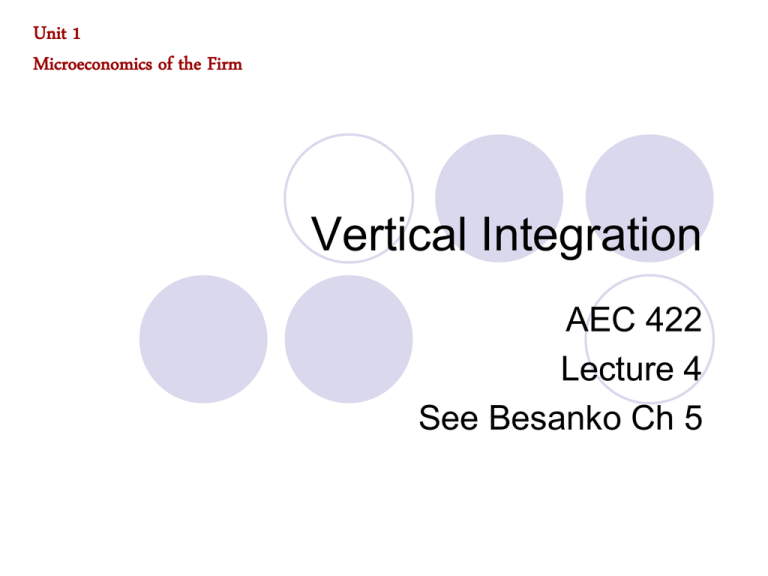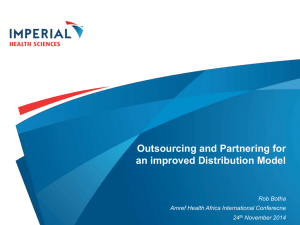Sept 12, 2012 - Vertical Chain
advertisement

Unit 1 Microeconomics of the Firm Vertical Integration AEC 422 Lecture 4 See Besanko Ch 5 Vertical Chain Begins with the acquisition of raw materials Ends with the sale of finished goods/services Can include support services such as Finance and Marketing Organizing the vertical chain is an important part of business strategy Channel management Organization of the Business Firm Infrastructure Support activities Human Resource Management Technology Development Procurement Porter’s Organization of the Firm Margin & Sales Primary activities Marketing Profit Supply Chain Management “upstream” suppliers provide many kinds of resources to operate the firm. Most firms have many types of suppliers Scope of activities within a firm can be many Production, research, packaging, distribution Key Supplier or Partner YOUR FIRM Many small firms choose to outsource to secure use of certain assets made available in the market by other firms Advertising Tax management Distribution Web management Key Customer Supply Chain Management “upstream” suppliers provide many kinds of resources to operate the firm. Scope of activities within a firm can be many Production, research, packaging, distribution Key Supplier or Partner Many small firms choose to outsource to secure use of certain assets made available in the market by other firms Advertising Tax management Distribution Web management YOUR FIRM Key Customer Outsourcing and integrating UPS Supply Chain Solutions Papa Johns Foodservice, Inc. Accountemps - Accounting Staffing Agency Vineyard – winery Web design Q-Labs microbial testing Upstream Firm Downstream Vertical Boundaries of the Firm Which steps of the vertical chain are to be performed inside the firm? Which steps of the vertical chain to be outsourced? Choice between the “invisible hand” of the market and the “visible hand” of the organization (Make or Buy) Like criteria for scope economies – which system is cheaper? Some creative uses of outsourcing – implications for the balance sheet Make or Buy Continuum Arm’s length Market Transactions Less Integrated Long-Term Contracts Strategic Alliances/Joint Ventures Vertical Coord. Parent/Subsidiary Relationship More Integrated Perform Activity Internally Do we make it ourselves or buy it? Decision depends on the costs and benefits of using the market as opposed to performing the task in-house Outside specialists may perform a task better than the firm can Intermediate solutions are possible (Examples: Strategic alliances with suppliers, Joint ventures) Do we make it ourselves or buy it? Other factors Frequency and volume of purchase/need Uniqueness of the asset Proprietary nature of the product Also relates to the merger & acquisition issue Sometimes the best strategy is to pursue vertical integration Grape Sourcing by MidSouth Wineries % Grown in % contracted % purchased own with other on spot vineyards growers market Small (<3000 cases) Large (3000 or more cases) 64.1 29.0 6.2 45.4 41.5 11.9 Source: 2011 Winery Price and Market Survey Elk Creek Winery, KY Benefits and Costs of Using the Market BENEFITS: - can be cheaper Market Firms Can Achieve Economies of Scale: In-House Production May Be Too Low Market Firms Must Be Efficient to Survive In The Market Environment COSTS: - may be hidden costs Coordination May Be Compromised Private Information May Be Leaked There May Be High Transaction Costs In The Market ie, search, paperwork, post-purchase recourse Benefits of Using the Market Market firms (outside specialists) may have patents/proprietary information that makes low cost production possible Market firms can sometimes achieve economies that inhouse units cannot Market firms are subject to market discipline, whereas inhouse units may be able to hide their inefficiencies behind overall corporate success (Agency and influence costs) Often there are choices in channel partners with which to work Agency Costs Does the outside firm have the same commitment to the delivery of the product or service needed? Not always - conflicts of interest, other clients Example: Purity Foods, Inc. Can have internal agency costs, too – managers & workers knowingly do not act in the best interest of the business Influence costs In addition to internal agency costs, performing a task in-house will lead to “influence costs” as well Influence cost – time consumed by a manager campaigning central management to allocate resources to his/her division Note – a poor process of external “bidding” can add to the cost of outsourcing, as well. Need to find the right firm the first time. Problems in Using the Market: Lack of Control Costs imposed by poor coordination Reluctance of partners to share valuable private information Transactions cost that can be avoided by performing the task in-house Each problem can be traced to difficulties in contracting Candy New Product Development Upstream Firm New Product Development Stages Downstream Buyer Involved Buyer Not Involved Supplier Involved Supplier Not Involved months of development time Concept Search 1.9 2.4 2.0 2.3 Concept Screening 2.5 0.6 1.3 0.7 Concept Testing 1.6 0.7 1.5 0.8 Business Analysis 2.9 1.7 2.2 1.8 Product Development 3.4 3.0 3.0 2.0 Product Testing 2.3 0.9 1.2 0.7 Commercialization 3.3 2.1 2.3 1.9 …..outsourcing generally adds to development time. Source: Woods and Spaulding, J Food Distr Research 2006 Make or Buy Continuum Arm’s length Market Transactions Less Integrated Long-Term Contracts Strategic Alliances/Joint Ventures Vertical Coord. Parent/Subsidiary Relationship More Integrated Perform Activity Internally Complete Contract A complete contract stipulates what each party should do for every possible contingency No party can exploit others’ weaknesses To create a complete contract one should be able to contemplate all possible contingencies One should be able to “map” from each possible contingency to a set of actions One should be able to define and measure performances One should be able to enforce the contract Complete Contract (Continued) To enforce a contract, an outside party (judge, arbitrator) should be able to observe the contingency observe the actions by the parties impose the stated penalties for nonperformance Real life contracts are usually incomplete contracts Incomplete Contracts Incomplete contracts Involve some ambiguities Need not anticipate all possible contingencies Do not spell out rights and responsibilities of parties completely Factors that Prevent Complete Contracting Bounded rationality Difficulties in specifying/measuring performance Asymmetric information Bounded Rationality Individuals have limited capacity to Process information Deal with complexity Pursue rational aims Individuals cannot foresee all possible contingencies Specifying/Measuring Performance Terms like “normal wear and tear” may have different interpretations Performance cannot always be measured unambiguously Asymmetric Information Parties to the contract may not have equal access to contract-relevant information One party can misrepresent information Limitations of Contract Law Doctrines of contract law are in broad language that could be interpreted in different ways Litigation can be a costly way to deal with breach of contract Litigation can be time consuming Litigation weakens the business relationship Coordination of Production Flows For successful coordination one party needs to make decisions that depend on the decision made by others A good fit should be accomplished in several dimensions Timing Size Color Case in point: Private Label Grocery Products Sequence R & D Coordination Problems Without good coordination, bottlenecks arise in the vertical chain Coordination is especially important when “design attributes” are present To ensure coordination, firms rely on contracts that specify delivery dates, design tolerances and other performance targets Design Attributes Design attributes are attributes that need to relate to each other precisely; else significant loss in economic value results Some examples Sequencing of courses in MBA curriculum Fit of auto sunroof glass to aperture Timely delivery of a critical component Design Attributes If coordination is critical, administration control may replace the market mechanism Design attributes may be moved in-house Pepsi-Cola and its Bottlers Make or Buy Continuum Arm’s length Market Transactions Less Integrated Long-Term Contracts Strategic Alliances/Joint Ventures Vertical Coord. Parent/Subsidiary Relationship More Integrated Perform Activity Internally Alternatives to Vertical Integration Tapered integration (making some and buying the rest) Joint ventures and strategic alliances Long term collaborative relationships Implicit contracts between firms Tapered Integration in Gasoline Retailing Major oil refiners sell through their own service stations and through independently owned stations As gas stations have moved away from auto repair and maintenance services, the proportion of company owned stations are growing Alliance Relationships Transaction based Alliance based Short-term relationships Multiple suppliers Adversarial relationships Price dominates Minimal investment from suppliers Long-term relationships Fewer suppliers Cooperative partnerships Value-added services dominate High investment for both buyer and supplier Extensive product, marketing, and logistics information sharing Firms are interdependent with joint decision making Extensive interaction between buyer and supplier functional areas Minimal information sharing Firms are independent Minimal interaction between respective functional areas Source: D. Ross: Competing Through Supply Chain Management, 1999 Supply Chain Management Integration (make or buy) ultimately about the structure that delivers the greatest value Internal vs external economies Key Supplier or Partner YOUR FIRM Key Customer











